Site Isolation¶
In the simplest case of loading a document with no iframes and no popups, we have a WebPageProxy and one WebProcess, one Page in that process, and that Page has one Frame that is a LocalFrame like this:
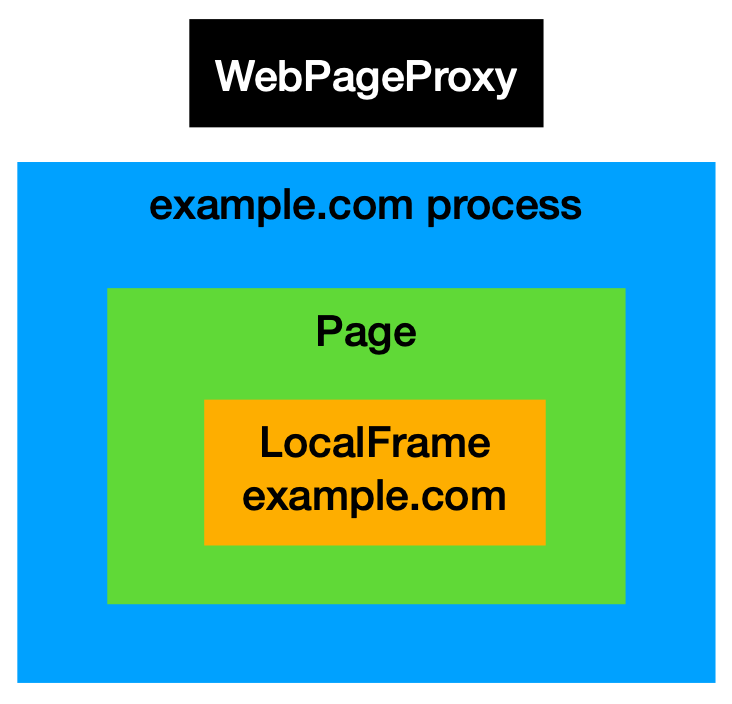
If that document has 2 iframes loaded from the same site, then the Frames are arranged in a FrameTree structure like this:
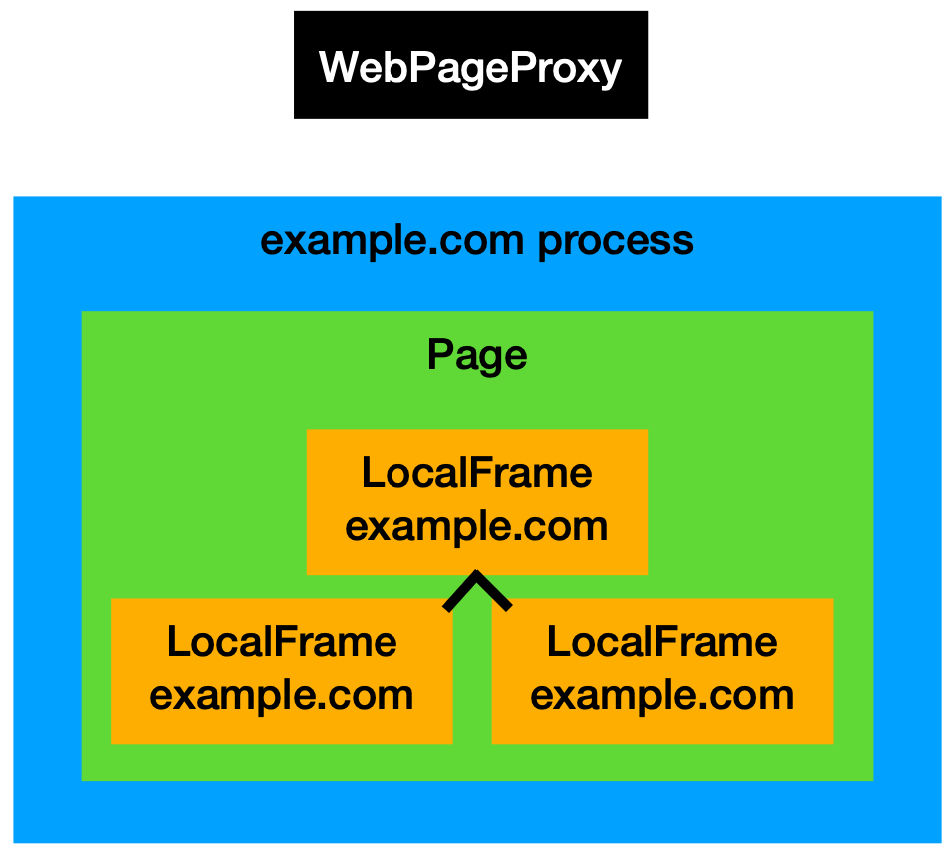
With site isolation off, if example.com loaded an iframe from a different site like a.com, then we would load it in the same process:
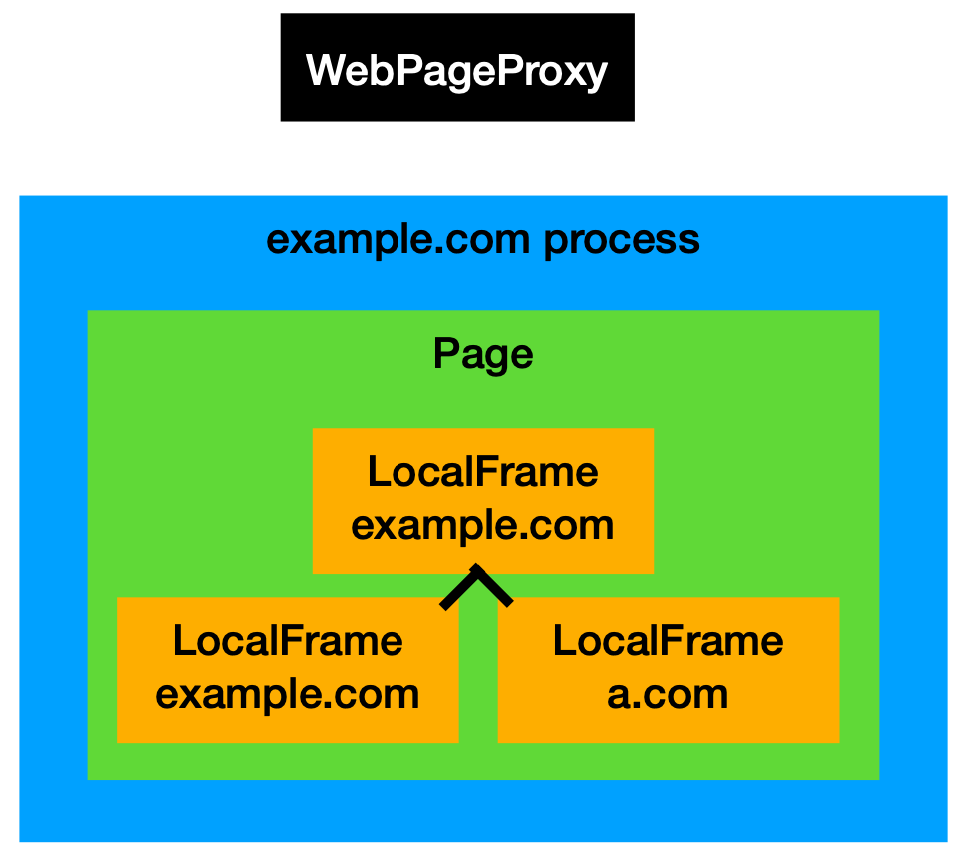
With site isolation on, though, we put the content from a.com into a different process than the content from example.com
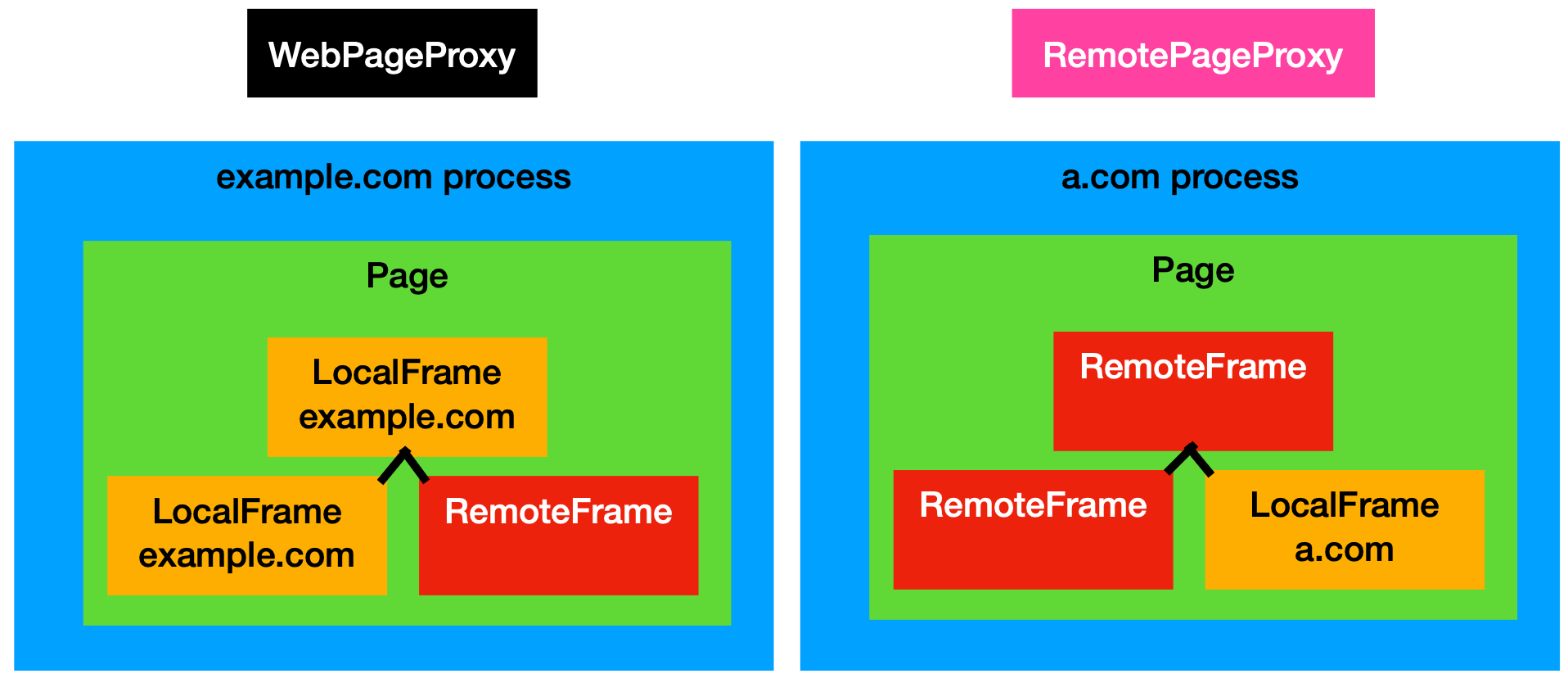
RemoteFrame¶
A RemoteFrame is used to indicate a position in the FrameTree that has a Frame that has a Document in a different process. This is needed because JavaScript can traverse the FrameTree even when it can’t access the DOM in a third-party Frame. The process that has the main frame at the top of the FrameTree as a LocalFrame communicates via IPC with the WebPageProxy, but all other processes have a RemoteFrame at the top of the FrameTree and they communicate directly with a RemotePageProxy, which mostly just relays messages to the WebPageProxy.
If the main frame calls window.open(‘https://b.com') then we need to have 3 processes:
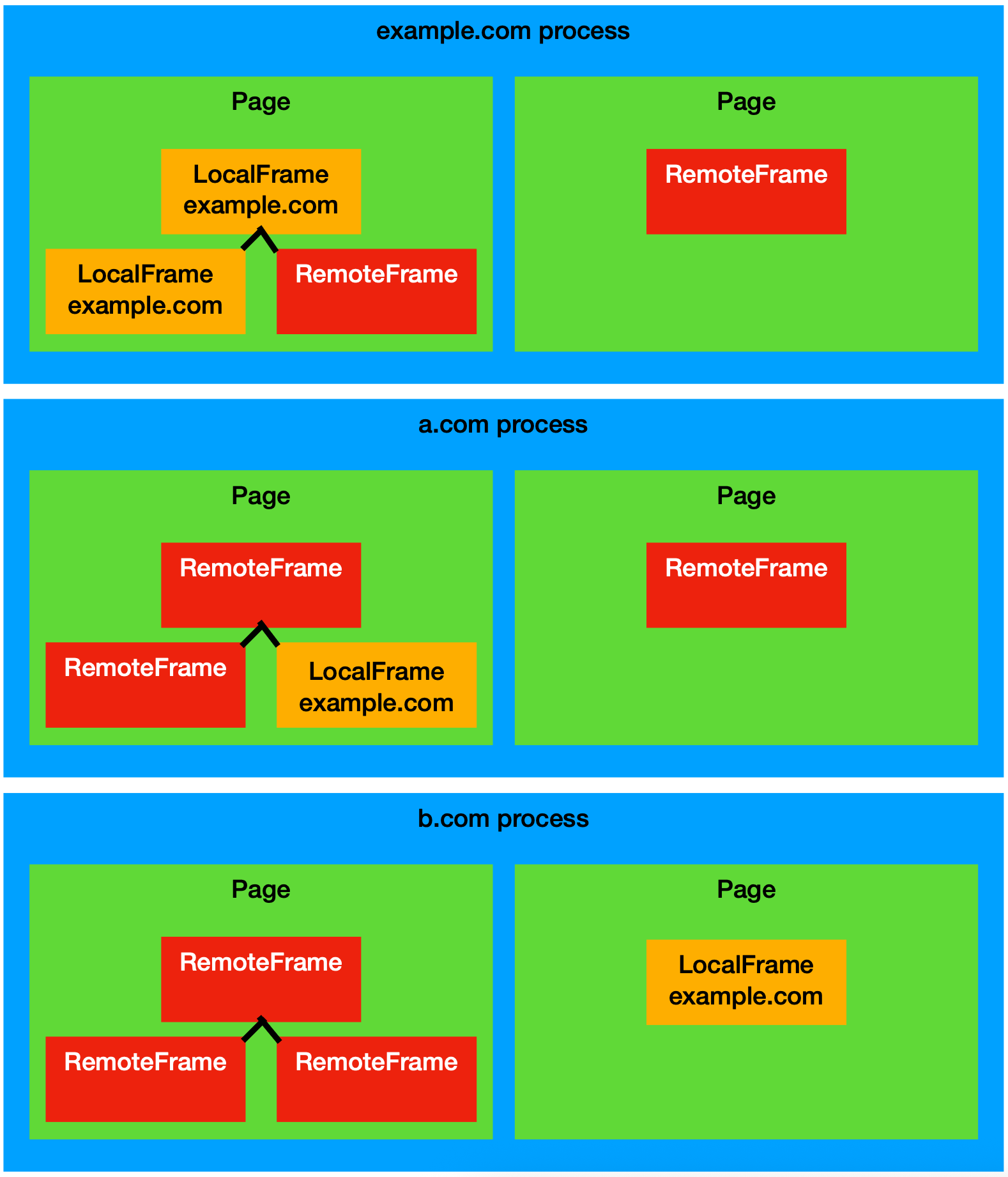
Each process needs to have the entire representation of the FrameTree because JavaScript has the ability to traverse the FrameTree by using properties like window.parent.opener.frames[1] and if it finds a Frame of the right origin it can access its DOM.
BrowsingContextGroup¶
A BrowsingContextGroup represents all the WebPageProxy objects that may be connected with opener relationships and all the processes they are currently using for their content. When a Frame navigates to a new domain, then the entire forest of FrameTrees needs to be recreated in the new process. Also, when a new WebPageProxy is created by a call to window.open, then all the existing processes need to be notified that a new Page was created with a main Frame.
DocumentSyncData¶
The existence of Frames is not the only thing that needs to have updates broadcast to all processes. Certain properties, such as the Frame name (which can be used as the second parameter of window.open to reuse a frame instead of making a new WebPageProxy) need to also be kept up to date as well as possible in all processes. Sending synchronous IPC for updates would keep things the most synchronized, but the browser would quickly become unresponsive. Instead, we broadcast updates to each process while keeping the UI process as the source of truth that is either the same as the state in each web content process or the web content process is about to receive a message with an update. That’s what DocumentSyncData is. It is a set of properties that we try to keep as up to date as possible in all processes.
Main and Root Frames¶
Each Frame has a main Frame, which is the Frame at the top of the FrameTree in that process. Not every frame has a LocalFrame as its main Frame. Sometimes, for purposes such as render layer tree transactions, we want the collection of LocalFrames that are at the top of their local FrameTree. These are LocalFrames that either have no parent (in the process that has the main frame) or LocalFrames that have a RemoteFrame as a parent. Page::rootFrames is how we quickly access these “root” frames. See this deep FrameTree example. The main frame is at example.com, and it has 2 iframes, one at example.com and one at a.com, and each iframe has a grandchild iframe with the opposite site:
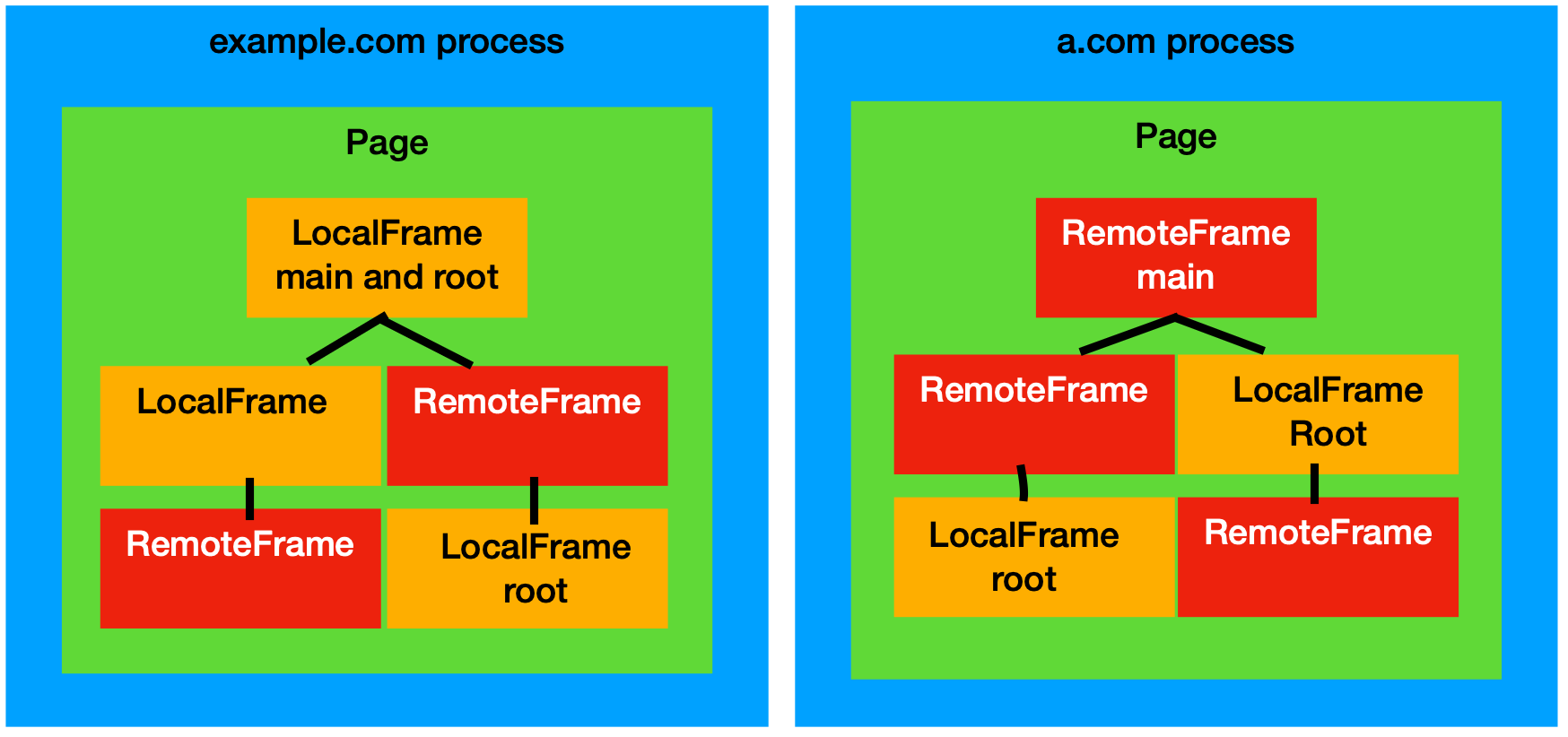
Site¶
Site isolation puts content from different Sites into different processes. A Site is the protocol and eTLD+1 (RegistrableDomain) of the domain. For example, http://example.com and https://example.com would be in different processes. https://www.example.com and https://blog.example.com and https://example.com would all be in the same process. http://example.co.uk and http://blog.example.co.uk would also be in the same process.
FrameProcess¶
If web content has many iframes in different processes, then the main frame removes all its iframes using JavaScript like iframe.parentNode.removeChild(iframe), we want to stop using all the now-unused processes. FrameProcess exists to keep track of which frames are using which processes with site isolation. Once a FrameProcess is destroyed, the WebProcessProxy it represents is either terminated or put in the WebProcessCache. The FrameProcess destruction means the BrowsingContextGroup is no longer keeping track of the web content process, but because the WebProcessProxy may be reused by the WebProcessCache the FrameProcess and WebProcessProxy need separate lifetimes.
Provisional Navigation¶
A frame can have local presence in multiple processes at the same time for a short amount of time during navigation. When an iframe navigates from a.com to b.com, it creates a ProvisionalFrameProxy which owns a FrameProcess for b.com. Inside the b.com process, the corresponding WebFrame will make a LocalFrame and own it with m_provisionalFrame instead of putting it in the FrameTree until the response is received from the network. This is needed because if postMessage is called in the b.com process to send a message to the frame that is navigating, we will want to use the RemoteFrame for delivery of that message, not the LocalFrame which isn't in the tree yet. Also, if the provisional load fails, such as if the TCP connection is lost before receiving a response, we can discard the provisional frame and have the frame trees be unaltered. When the response is received successfully, the RemoteFrame will be replaced by the LocalFrame in the FrameTree in the b.com process and a message will be sent to the a.com process telling it to replace its LocalFrame with a RemoteFrame because the frame is showing content from b.com now. When the main frame navigates, we use a ProvisionalPageProxy instead of a ProvisionalFrameProxy.
Before navigation:
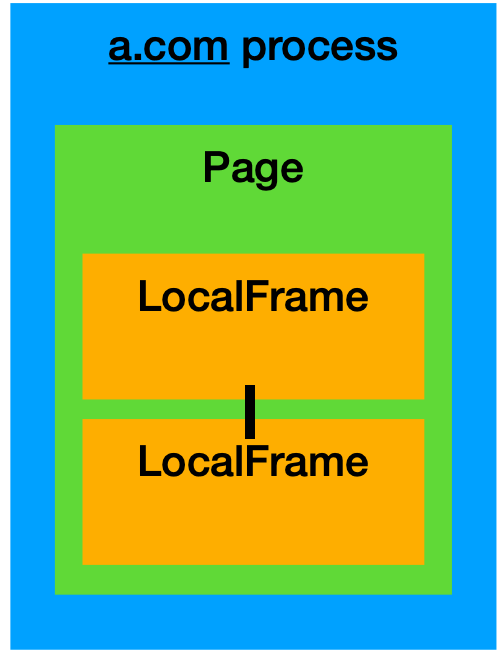 Between request sent and response received:
Between request sent and response received:
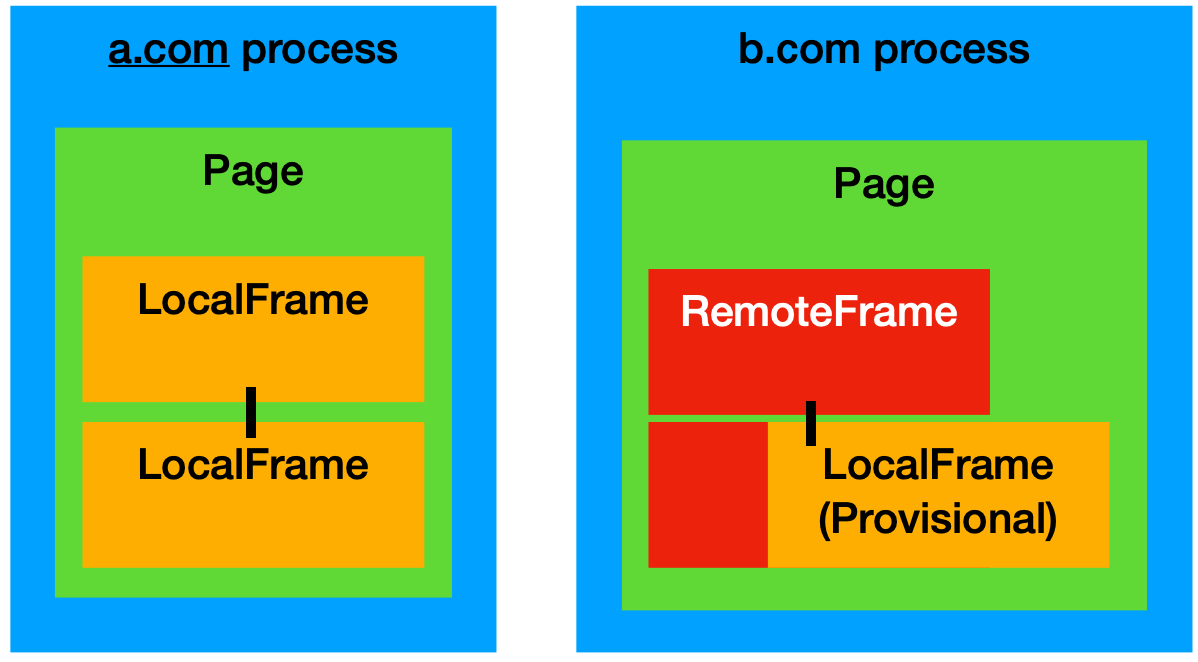 Immediately after b.com process is informed of response received:
Immediately after b.com process is informed of response received:
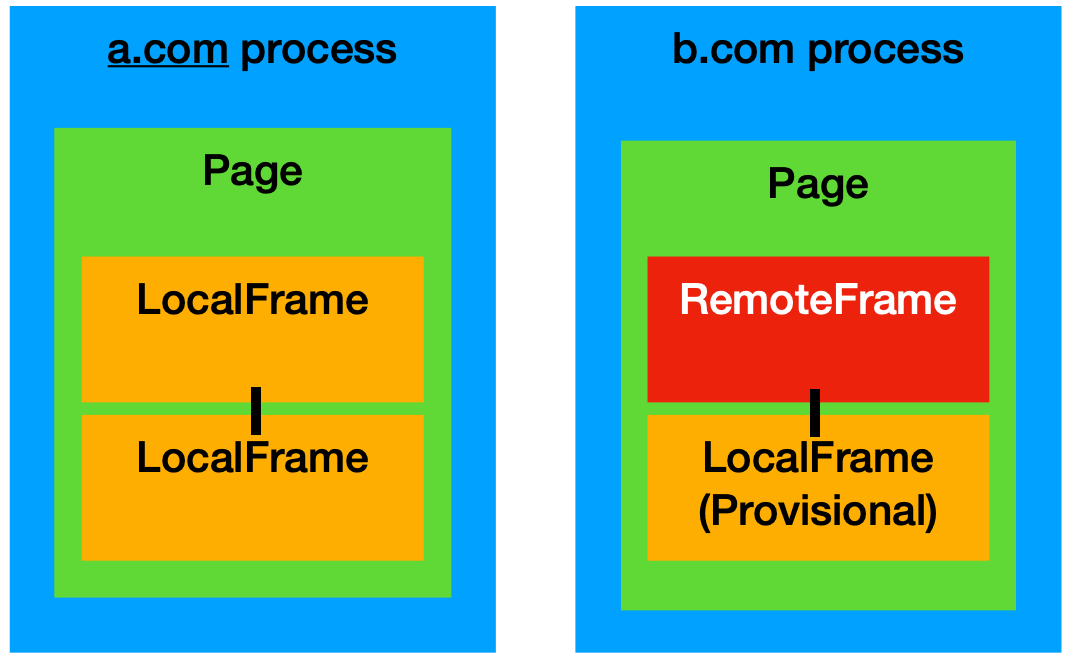 After IPC notifies other processes that response was received in b.com process:
After IPC notifies other processes that response was received in b.com process:
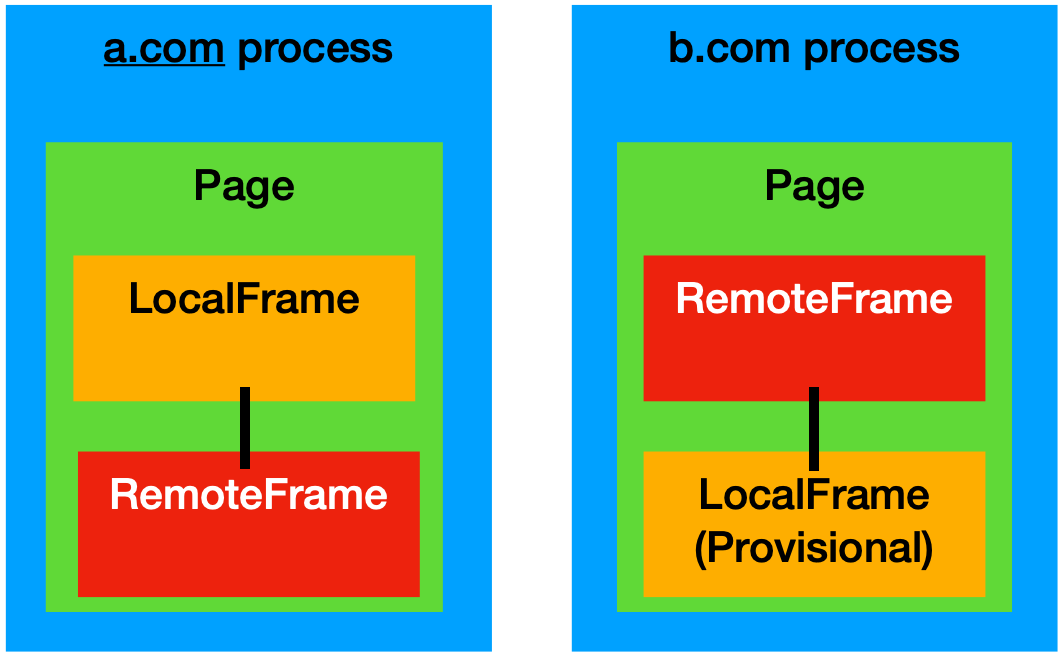
New Communication Channels¶
To get from a WebCore::Page to the WebKit::WebPage that wraps it, you can go through the ChromeClient. To get from a WebCore::LocalFrame to the WebKit::WebFrame that wraps it, you can go through the FrameLoaderClient. To get from a WebCore::RemoteFrame to the WebKit::WebFrame that wraps it, we added RemoteFrameClient. To send a message to all web content processes, use WebPageProxy::forEachWebContentProcess. To send a message to a specific web content process, use WebPageProxy::sendToProcessContainingFrame
Tests¶
We currently have about 90k layout tests which have relatively good code coverage to verify that each feature of WebKit works as desired. We introduced a special mode to WebKitTestRunner that can be accessed by adding the --site-isolation flag to run-webkit-tests for running tests for reusing these tests to get as much coverage as possible specific to site isolation. When using this flag, we run the test in a cross-site iframe with site isolation off, gather any output the test emits, then run the same test in a cross-site iframe with site isolation on, and compare the output. If the output is different, it usually indicates something we haven’t yet implemented for site isolation. Some tests don’t complete when run in a cross-site iframe, and these tests aren’t helpful in this mode, but most do complete and are useful. We have a test expectations file at LayoutTests/platform/mac-site-isolation/TestExpectations and a bot running these tests that you can see by going to results.webkit.org then clicking “Suites” at the top then “Flavor” on the bottom right and turning on site-isolation. We also have API tests that you can run with “run-webkit-tests SiteIsolation -v —no-build” and some layout tests written specifically to test interesting cases of site isolation in LayoutTests/http/tests/site-isolation.
Finding what needs to be done¶
Site isolation was originally planned as a simple 3 step project: 1. Put frames from each Site into their own process 2. Fix the functionality broken by step 1 3. Fix the performance regression from step 2 As of January 2025 are currently on step 2 and looking forward to step 3. In order to get there, we need to fix all subtasks of rdar://99665363 which is organized from a code-centric perspective. QA has also been helping find things to fix from a user-centric perspective, and they are subtasks of rdar://138794978. Those that don't have access to radar can reach out on the WebKit Slack.
Strategies for fixing bugs¶
Most of the functionality bugs remaining can be described as “we used to follow a pointer to another frame and now we can’t.” A handful of strategies continue to be quite effective. The first is maybe we can refactor the code to send a message to the frame via IPC instead of calling a function and operating on the frame directly when we need to do something. The second is maybe see if we can proactively send state to all processes so when they need to do something they already have the necessary information. This should only be done with information that is not sensitive because it creates a side channel for speculative execution attacks to read information other sites should not have access to. The third is maybe we can do something in a privileged process such as the UI process or the GPU process that doesn’t have web content in it but can communicate and know state from multiple sites. And the fourth is maybe it is correct to do nothing if a frame is in another process. This last option is rare, but sometimes if access is gated on an origin check it is correct to skip a frame in another process.